Mark Sisson's Blog, page 60
October 17, 2020
Creamy Golden Milk Turmeric Tea Recipe
 To call this beverage tea might be a little misleading. “Creamy Mug of Cozy, Warming Deliciousness” is more accurate. It just plain feels good to drink this lightly sweet, vibrant blend of heated almond (or coconut) milk, turmeric, ginger, cayenne and honey. Turmeric tea will perk you up in the morning, calm you down at night and soothe sniffles and sore throats. It’s also a really pleasant way to end a meal.
To call this beverage tea might be a little misleading. “Creamy Mug of Cozy, Warming Deliciousness” is more accurate. It just plain feels good to drink this lightly sweet, vibrant blend of heated almond (or coconut) milk, turmeric, ginger, cayenne and honey. Turmeric tea will perk you up in the morning, calm you down at night and soothe sniffles and sore throats. It’s also a really pleasant way to end a meal.
At first glance, the ingredients might not sound like a combination you’d want to drink. Something magical happens in the mug, though, and the result is richer than regular tea, less intense than coffee and oddly delicious. Turmeric is the dominant flavor and admittedly, one that takes a little getting used to. Although not spicy itself, turmeric’s slightly bitter, earthy flavor is the perfect backdrop for other spices, which is why it’s a main ingredient in curry powder. The ginger and cayenne in this tea aren’t overwhelming because they’re floating in creamy, turmeric-infused milk that’s been lightly sweetened.
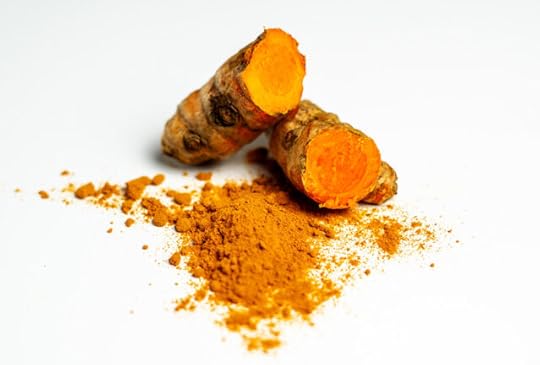
Turmeric is ginger’s mellow cousin and is a root used just as often for its bright yellow-orange color as it is for flavor. Turmeric powder is a frequent ingredient in East Indian, Middle Eastern, South Asian and Caribbean cooking and is also believed to have numerous healing properties. When cooking with turmeric, it’s most often used in conjunction with ginger and spices like cumin, cinnamon and coriander. Moroccan Chicken Casserole is one dish that benefits from turmeric’s flavor. If you’d like to use turmeric more often, you can also add extra turmeric to dishes that already have curry powder in them, like Butter Chicken or Beef Curry Meatballs. Or, after trying this recipe, you might just go through all the turmeric in your spice rack by brewing mugs of Golden Milk.
Two-ingredient Shortcut: Mix Golden Turmeric Collagen Fuel with warm almond or coconut milk. Just add mug.
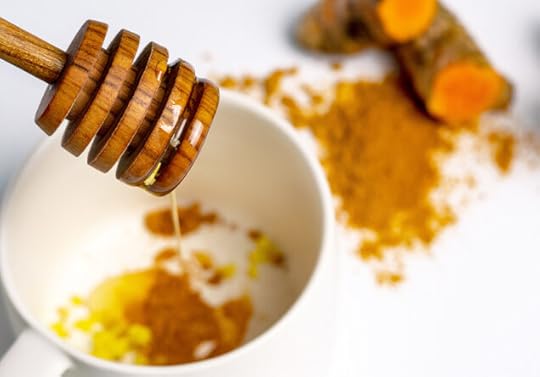
Serv ings: 1 cup of tea
Ingredients:
8 ounces (1 cup) almond or coconut milk
1/2 teaspoon turmeric
1/2-inch wide round slice of ginger root, peeled and finely chopped
Dash of cayenne pepper
1/2 – 1 teaspoon honey or other sweetener
Optional additions: a small pat of butter, cinnamon, cardamom, scoop of unflavored collagen peptides
Instructions:
Gently warm the almond or coconut milk on the stove.
In a mug, combine the remaining ingredients.
Drizzle a teaspoon of the warmed milk into the mug and mix until the liquid is smooth with no lumps. Add the rest of the milk and mix well. You can leave the pieces of ginger in the tea, or strain it out before drinking.

Looking for more turmeric inspiration? Try these recipes to add a earthy flavor to your next meal.
Turmeric Kale Soup with Ground Lamb
Pork Chops in Creamy Turmeric Sauce
For more ways to use turmeric in your routine, pick up a canister of Primal Kitchen Collagen Fuel in Golden Turmeric.

The post Creamy Golden Milk Turmeric Tea Recipe appeared first on Mark's Daily Apple.



October 16, 2020
Weekly Link Love — Edition 103

Research of the Week
When pigs made it to Europe, their genes were completely overturned.
The genetic formation of the first Americans.
We’re more likely to remember the locations of places where we consumed high calorie meals. Makes sense.
Religious rituals trigger endogenous opioids.
Late night eating tends to be a bad idea.
New Primal Blueprint Podcasts
Episode 451: Kyrin Dunston MD, OBGYN: Host Elle Russ welcomes Dr. Kyrin Dunston to the podcast, an OBGYN-turned-functional-medicine doctor.
Primal Health Coach Radio Episode 80: Laura and Erin chat with Chrisa Zindra Boyce, a leader in the Handel Group who specializes in helping people realize their professional visions.
Media, Schmedia
Should we re-introduce predators to wild areas without them?
Mexico blocks the sale of some “cheeses” for containing vegetable fat.
Interesting Blog Posts
Science should really stop ignoring small farms.
What might a “new morality” look like?
Social Notes
True.
Everything Else
This is what they feed to diabetics.
The flaws of calorie counting explained.
Things I’m Up to and Interested In
This should be in every homeschooler’s curriculum: Traditional French butter making.
Interesting new online magazine: Hyperion. Some health content, some future-casting about cities and AI, and other interesting stuff.
Great question: Vitamin D is cheap, plentiful, and it works. Why aren’t we using it?
Interesting question: What happens when you sever the connection between hunter-foragers and their prey?
Do babies need to eat meat?: Yes. Pay-walled, but the answer is yes.
Question I’m Asking
What would you add to school curriculums if you had ultimate power?
Recipe Corner
Indian spiced burger patty.
Baby, it’s stew season. Instant pot beef stew.
Time Capsule
One year ago (Oct 9 – Oct 15)
Keto and Cancer: Where Do We Stand? – What’s the deal?
A Primal Guide to Blood Pressure: 8 Common (and Not So Common) Interventions – What might work.
Comment of the Week
“I wonder if increased dreaming happened at other stressful historical times? We’ve had them about every 80 years; the Revolution, the Civil War, WW2, and now (right on time). Strauss-Howe generational theory would suggest we are in a Fourth Turning, with an unknown large event still coming. Regardless what you think of that, historically we have not returned to an Era of Good Feeling without going through a massive calamity, larger than the last Fourth Turning was. Stay tuned, it might get worse..”
-Interesting question, jeff.
The post Weekly Link Love — Edition 103 appeared first on Mark's Daily Apple.



October 15, 2020
What it Really Means When You’re Overwhelmed (and 4 Ways to Move Past It)
 Raise your hand if you’ve been feeling a little overwhelmed. Aside from the fact that being in the middle of a pandemic makes everything more stressful, you’ve got work obligations and family commitments, then there are food choices to make, at-home workouts you think you should be doing, and non-stretchy pants you’re feeling bad for not fitting into.
Raise your hand if you’ve been feeling a little overwhelmed. Aside from the fact that being in the middle of a pandemic makes everything more stressful, you’ve got work obligations and family commitments, then there are food choices to make, at-home workouts you think you should be doing, and non-stretchy pants you’re feeling bad for not fitting into.
It’s a lot. I get it, and it’s totally normal to feel overwhelmed. That said, staying in a state of overwhelm is a choice.
Yep, you heard me, it’s a choice. And if you’re ready to get out of the seemingly relentless spin cycle of life (and the tight chest and racing mind that come with it), stick around. I’ll be unpacking the real reason you get overwhelmed — spoiler alert, it’s not because your to-do list is too long — plus, four things you can do to change it.
Why Do I Get Overwhelmed?
I’ll give you an example from my own life. As a health coach, I’ll often hear my clients say that they just can’t do it. They can’t swap out their toast and cereal for breakfast. They can’t make time to get outside. They can’t get to bed earlier. They can’t…fill in the blank.
In my opinion, “I can’t” statements reflect limiting beliefs. They aren’t real; they’re just stories we tell ourselves, and identities we accidentally end up identifying with. It’s not that you can’t, it’s that something is holding you back. I find that most of the time, when I dig a little deeper, that thing is fear.
Types of Fear That Cause Overwhelm:
Fear you won’t be able to handle it
Fear of getting it wrong
Fear you won’t get it done (on time)
Fear that you’ll be judged
Fear of the consequences
Fear of not being in control
Fear of being embarrassed
Fear that you don’t really deserve it
Whether you’re experiencing worry, stress, or complete overwhelm, fear is usually at the helm, just FYI. But the goal here isn’t to be fearless (there actually are some benefits to fear),1 it’s to not let it rule your life.
Anything that threatens your place in this world, i.e. your self-worth, can elicit a fear-based reaction. I’m sure you’ve heard of the fight-or-flight response, right? When you experience something that feels scary and stressful, the amygdala (the part of your brain that handles emotional processing) releases a rush of chemicals into the body.2 The stress hormones, adrenaline and cortisol flood your system, preparing you to fight or flee. Not only that, the amygdala instantly shuts down the neural pathway to your prefrontal cortex which temporarily impairs all rational thinking, making you feel disorganized and out of control.3
So, It’s All in My Mind?
Believe it or not, you’re causing this cascade of physiological effects by your thoughts alone, even though there’s no real danger other than the perceived consequences of what would happen if you failed or were embarrassed or weren’t able to keep tabs on all of your to-dos. When you’re feeling overwhelmed, your life isn’t falling apart — your thoughts are.
So, how do you reel it back in? This Yale studyshowed that it could be as simple as breathing.4 Researchers placed 131 university students into either a non-intervention control group or one of three 30-hour workshops that used wellbeing interventions, including breathing, mindfulness, and emotional awareness to combat stress. Before and after the workshops, the students were put through a stressful task that simulated a high-pressure performance situation.
They found that the group who participated in the breathing workshop were able to stay calm throughout the high-stress task. Plus, their heart rates held steady, they were able to think more clearly, and they actually performed the task more effectively.
4 Ways to Stop Yourself from Spiraling
Without a doubt, overwhelm is one of the greatest barriers to achieving your goals, but it is possible to move past it. It’s just your brain trying to keep you safe and with the strategies below, you’ll learn how to recognize the onset of overwhelm and take steps to regain the clarity and calm you need to get whatever it is you need to do, done.
Breathe
Since being in that state of overwhelm impairs your prefrontal cortex and sends adrenaline and cortisol coursing through your body, the best thing you can do for yourself is to slow down and breathe.5 It doesn’t matter what kind of breathing you do — box breathing, alternating nostril breathing, and diaphragmatic breathing all work. Just make sure that the method you choose is rhythmic, meaning that you breathe in and out for about the same amount of time. After a few minutes you’ll notice that your mind has slowed down and your energy is much calmer.
Try this: Here is a triangular breath exercise that I’ve created for my clients. Inhale through your nose, counting slowly to 6; hold for a count of 2 at the top; and exhale for a count of 8. Repeat for 1-3 minutes or until your mind feels calm again.
Check Your Stories
You know the limiting beliefs and thoughts that prevent you from achieving your goals? These are your stories. And I call them stories because they’re just not true. You may have picked them up from things you heard your parents say growing up or from an experience you went through. Maybe you decided along that you always drop the ball. Or that things always feel too big for you, and who were you to achieve big things anyway?! These narratives become a form of identity that not only reflects who we think we are, but also what we think is possible for us.
Try this: Next time you catch yourself doubting your greatness, turn it on its ear. Instead of saying, “I don’t think I can stick to a new way of eating” try “I am fully capable of doing new things.”
Take the Stairstep Approach
When I work with new clients, they often feel overwhelmed by all the things they think they have to do. There’s cleaning out the cabinets, figuring out which brands are canola-free, learning how to make their own bone broth/kombucha/beet kvass… This is about the time I sneak in my stair-stepping approach. This technique is awesome because it breaks the journey down into smaller steps, which is less intimidating than trying to leap to the end in a single bound.
Try this: On a piece of paper, literally draw a staircase. Identify the bottom step (this is where you are now) and then identify the top step (this is where you want to go). Figure out the very first thing you need to do to get to the next step, then do that thing! The rest of the steps will reveal themselves as you go.
Delegate
Just because you can do all the things, doesn’t mean you need to. A lot of times we get overwhelmed simply because we put too much on our plates. Just like there’s no gold medal for getting more done, there’s no punishment for doing less. Your worthiness has nothing to do with how much you accomplish or don’t accomplish. That being said, there’s also no shame in delegating out tasks and responsibilities.
Try this: Think about what areas of your life could use some assistance. Can your spouse cook up a healthy dinner tonight? Can your kids help you sort through Primal recipes? Make a list of the tasks you want to dole out and if you need help getting more comfortable with asking for help, read this.
Go From “I Can’t” to “I Got This”
Life can be overwhelming, even when you’re not in the middle of a pandemic. But by paying attention to your triggers, your stories, and your breath, you can restore your ability to think, to listen, and move forward. It does take practice, but eventually you can train yourself to respond rather than react. Follow these four steps and see how it works for you:
Breathe
Check your Stories
Take the Stairstep Approach
Delegate
How do you manage overwhelm? What tactics do you use to move through it or avoid it all together?
References https://www.huffpost.com/entry/why-fear-is-a-good-thing_b_8258746https://www.ncbi.nlm.nih.gov/pmc/articles/PMC2882379/https://www.ncbi.nlm.nih.gov/pmc/articles/PMC4774859/https://www.frontiersin.org/articles/...https://www.marksdailyapple.com/deep-breathing/
The post What it Really Means When You’re Overwhelmed (and 4 Ways to Move Past It) appeared first on Mark's Daily Apple.



October 14, 2020
Starting Solids: When Can Babies Eat Table Food?
 Babies can’t live off milk forever. Eventually they must join the rest of us in eating solid food. But how should it happen?
Babies can’t live off milk forever. Eventually they must join the rest of us in eating solid food. But how should it happen?
The baby food industry has everyone fooled. You don’t need them. There’s actually more research that goes into commercial pet food than commercial baby food. For all its faults, dog and cat kibble at least has to adhere to certain nutrient standards. Commercial baby food is just random stuff blended up with enough pear or banana to taste sweet. And I’m not saying there’s something wrong with pears or bananas or green beans or whatever else they blend up and throw in those pouches. I’m just saying it’s not enough. You can do so much better with a little thought and innovation.
It’s not as hard as people think. I mean, these are people we’re feeding. Small people, but people. If you can feed yourself, you can feed a kid. If you’re reading this blog, you’re probably feeding yourself nutrient-dense whole foods. Well, do the same thing for your baby only in smaller portions and using different textures. Because there are limitations:
Babies starting solids generally don’t have teeth.
Babies starting solids are only used to drinking fluids. They have to get used to an entirely different state of matter.
Babies starting solids have yet to fulfill their genetic intelligence potential. In other words, they are completely useless.
So you can’t just throw a steak down in front of your seven month old and be done with it. You need a little more care. Here’s when and how to do it:
When to Start Solids
A good rule of thumb is to start a baby on solids when he or she begins showing interest in solid food. Don’t force it on them. Let it develop organically. However, don’t offer any solids before six months regardless of interest. Exclusive breast milk (or formula, if that’s what you’re doing) is that vital.
Some people will recommend that you supplement a “slow-growing” breastfed infant with solid food at four months or so, but I think that’s a mistake. According to the WHO’s birth charts, breastfed babies grow more “slowly” but this is normal. They grow as they’re supposed to grow, not as the solid foods are dictating. In its own FAQ, the CDC recommends against using the CDC growth chart for breastfed babies and admits that the WHO chart shows how “infants should grow rather than simply do grow.”
6 Developmental Signs of Readiness for Solids
Your baby may be ready for solids if she:
Is at least six months of age
Can sit up in a high chair unassisted
Has doubled her birth weight
Has lost the tongue-thrust reflex (if she doesn’t automatically spit out food placed on her tongue)
Shows interest in what you’re eating
Opens her mouth when food comes near her face
Tip: don’t start solids if your baby has a cold. Stuffy noses can make it hard to coordinate breathing and moving food around the mouth, and it may alter the taste of foods, turning your baby off to something she might otherwise like.
She’ll Have What You’re Having
You can drop a few hundred bucks on the infant food machine and refillable pouches and spend hours each week manufacturing your own goops and purees, or you could let your kid nibble on what you’re having for dinner. After all, you’re eating good, nutrient-dense food yourself, right? It’s probably perfect for your baby.
Don’t let me dissuade you from making your own goop. That works for many parents and it’s a great way to fine-tune exactly what your baby is getting. But it’s not the only way.
Start Small
Early solids are complementary, they cannot replace breast milk. Always nurse or feed milk before offering solids; that way your baby doesn’t fill up on food and reject the milk he needs. This also auto-regulates how much food the baby will eat.
Keep Nursing
Breastmilk isn’t just food. It’s also rich in immunoregulatory components that shape and guide the infant’s immune system. Feeding breastmilk as you introduce solid foods (in the same meal) will help your baby learn to tolerate the foods and reduce the risk of allergies.
The Perfect First Food
Here’s the official line:
Give rice cereal as the first complementary food. Make sure it’s fortified with iron, because iron-fortified rice cereal is the only way for an infant human to obtain the iron he desperately needs to grow and thrive.
Does that sound ridiculous to anyone else?
You know what else has iron? Meat. Sardines. Egg yolks. Liver. There are hundreds of foods with more and better iron than rice cereal. If a food has to be fortified with certain nutrients to become suitable in an infant’s early complementary diet, it’s not the perfect first food. Turns out that if you had to choose just one, meat is probably the most important early complementary food in an infant’s diet. In one landmark study, meat-eating breastfed infants had larger heads, better zinc statuses, and better behavior at 12 months than cereal-eating breastfed infants.1 It doesn’t get any clearer than that, folks.
Start Smooth, Progress to Lumpy
At six months, a baby can only eat smooth or semi-solid. Gradually increase the solidity of the offered foods as things progress. By 10 months, the baby should be eating “lumpy” foods, if only because that represents a critical window of acclimation to the texture. If you miss the window and continue only with smooth purees, the child may develop issues with pickiness later on down the road.
Baby-led Weaning
Baby-led weaning is a method of introducing solids that doesn’t involve spoons, until baby can use the spoon herself. At 6 months of age, bits of soft, chopped foods like banana, ripe avocado, cooked sweet potato, etc. are offered to the child and she experiments with what she wants – under the parent’s careful supervision, of course. The whole process is directed by the baby’s curiosity.
The idea behind it is that she will better regulate her self-feeding and eventually recognize satiety cues because there isn’t a parent sneaking in extra bites after she’s full. With baby-led weaning, little ones also have a chance to practice their fine motor skills by grasping food and bringing it to their own mouths themselves.
If you’re worried about chewing at first, there are infant self-feeders with handles that can help. (Get the silicone ones – the kind with netting are a pain to clean.)
What does this have to do with weaning? The idea is that over a period of months, as your baby becomes comfortable with eating more and more food, she will depend on breast milk or formula less and less, and eventually rely fully on solid food for nutrition.
Introduce Peanuts… Carefully
The latest research indicates that exposing infants to peanut products as an early complementary food reduces rather than increases the risk of peanut allergy. There’s an entire protocol for determining which infants are candidates for early exposure, so make sure you do this with your pediatrician’s understanding.
With all that out of the way, now’s the fun part. I’m going to post some dishes and recipes that little babies can eat.
The really cool thing about infants coming off breast milk is that they like almost everything. They’re up for it. You offer them some chicken liver paté and they will eat that up. If they don’t like it, they’ll at least try it (but they’ll probably like it).
An infant has no preconceived ideas about food. They’re too young to be influenced by peers or advertising. They’ve only been nursing, so they don’t have the chemically-altered sweet tooth of your average American child. They are relatively pure beings, motivated almost entirely by nutrients and calories. And lest you worry about “calories” or carbs for your young baby, calories are nutrients for growing babies and kids. They need the sheer caloric bulk to grow and construct their bodies.
Meat
What seems to work best as a first solid food is soft, shredded red meat. Maybe a chuck roast or shank cooked until fragile, then chopped, shredded, and doused in a little broth or even breast milk to soften it up.
How to introduce eggs to baby
Mash a banana.
Soft boil an egg and pierce the still-runny yolk; drain the yolk into the banana.
Mix well.
Serve it up. Tastes great, very nutrient-dense. Tons of choline, decent protein, and if you get a high-quality egg it will provide most of the B-vitamins, selenium, iodine, and even omega-3s an infant needs.
Mashed sardines
Mash sardines up (bone in and skin on, preferably) with the oil (if real olive oil). Good iron, calcium, protein, selenium, and omega-3s.
Smoked oysters
The Crown Prince smoked oysters in olive oil are fantastic, BPA-free, and an excellent source of zinc, iron, protein, B-12, and omega-3s. Probably iodine too. Great texture for beginners; just make sure to cut off the hard part that normally attaches to the shell. Since shellfish allergies are relatively common, ask your pediatrician about starting slow to watch for a reaction, and skip oysters for now if you have shellfish allergies in your family.
Mashed potatoes (or sweet potatoes)
I never hear about mashed potatoes given to babies as a weaning food, and I’m not sure why. Potatoes are actually quite nutritious as far as starches go. They have complete protein and a nice spread of minerals. Plus, you can sneak all sorts of stuff, like egg yolks, meat, seafood, and pureed veggies. Mash it with some breast milk or broth to make it smooth and creamy.
There isn’t much research on white potatoes as a complementary food, but sweet potato-based complementary foods have distinct advantages over grain-based infant foods, including lower phytate (which binds to and prevents the absorption of minerals) and higher vitamin A, especially if you’re also feeding meat.23
Canned cod livers
Canned cod livers are the smoothest, creamiest thing I’ve ever tried. Highly recommended and a fantastic source of vitamin A (pre-formed, animal version), DHA (important for baby brains), and vitamin D (you can expose your baby to sunlight within reason, but dietary vitamin D is also helpful). A little goes a long way—a tablespoon at a time is plenty to start.
Frozen and fresh fruit
Fresh fruit is ideal, of course, but it helps to keep frozen fruit on hand. You can take it out and chop it up and let it thaw a bit so it’s the right texture. You can feed it whole when your baby is older and able to handle larger chunks. You can mash it up and mix with soft boiled egg yolks.
Wild blueberries, cherries, mangos, oranges, big frozen strawberries (great for teething), peaches, melon, and even figs are fantastic choices and provide important vitamin C. Just keep a watchful eye on them when they’re eating smaller fruits that can get stuck in the trachea.
Yogurt
Full-fat, of course. Start with plain unsweetened. Some yogurt brands, especially the ones marketed to children, contain more sugar than a can of soda.
Salmon and salmon roe
Baby needs those omega-3s, that selenium, that protein, those B-vitamins, that astaxanthin, everything. Salmon is incredible for the developing brain. Poach the salmon until soft.
Liver and liver paté
Chicken liver from pastured chickens is the mildest of all the livers. It’s also the highest in iron and lowest in retinol, so it can be given a bit more often to babies than beef liver.
I’ve known many parents whose kids love liver paté. Perfect texture; you can even mix it up with rice cereal to “fortify” it.
Scrambled eggs
If there’s no reason to suspect an egg allergy, scrambled eggs are an easy snack. Do them Gordon Ramsay style for a creamy, smooth texture.
Grilled onions
Onions are a great source of inulin, a type of prebiotic fiber that can in some ways emulate the prebiotics found in breastmilk. Also, if a baby learns to love onions, she’ll probably love other types of pungent foods.
Meaty bones
I’m not saying you hand your kid a smoked turkey drumstick. But if you cook some beef shanks or an oxtail until the meat’s falling off the bone, the leftover bone with some gristle and soft meat is the perfect thing for your teething baby to gnaw on. The meat is soft enough that they can chew it up to an acceptable size and there’s not enough of it to risk any real choking. Besides, you’re there to watch them.
Better rice cereal
Average parents start their kids on rice cereal: dry rice cereal you mix with milk or formula until soft enough to suck down. They’ll put this stuff in the baby’s bottles. They’ll spoon it up into their gaping maws. It’s bland and basically pure starch and fills them up. Now, I have nothing against starch for kids. As I’ve said time and time before, babies need calories and they can use the glucose. I’d never recommend that babies go strict keto or anything (although there are people who do it and seem to report good things). But there’s so much more you can cram in that bland gruel to make it taste better and deliver important nutrients.
Egg yolks.
Chicken or beef liver.
Potatoes, sweet potatoes, or winter squash (offset some of the rice with these other starch sources).
Stewed chuck roast.
Ground meat.
Cooked carrots.
Avocado.
Salmon roe.
Salmon.
Green beans.
Rice gruel is a great vehicle. If you’re worried about the consistency with these additions, simply blend it up until it’s the right texture.
More Tips
Fish sauce: Add a touch of fish sauce to your foods to provide glutamate that helps the baby learn to love the food.
Get a stick blender: Easiest way in the world to puree foods or roughly chop them into the right texture. This is a good one.
Get 4 ounce mason jars: Very handy for storing and serving food.
Make a habit of making bone broth and keeping it frozen on hand: Broth is the tie that binds everything together. Wanna make rice cereal? Broth makes it more nutritious. Want to puree some veggies? Broth makes it more nutritious and taste better than water. Want to stew some meat until it’s soft enough for a baby to eat? Broth beats water again.
These are just a handful of the things you can feed your baby who’s starting solids. And you know what? It wouldn’t be such a bad list of foods to choose from when feeding yourself.
Now let’s hear from you. What did you feed your babies when introducing solids? What would you do differently?
Tell us down below!
Thanks for reading, everyone.
References https://pubmed.ncbi.nlm.nih.gov/16456417https://pubmed.ncbi.nlm.nih.gov/22624294/https://pubmed.ncbi.nlm.nih.gov/24791579/
The post Starting Solids: When Can Babies Eat Table Food? appeared first on Mark's Daily Apple.



October 13, 2020
How to Eat More Organ Meat
 Unless you’re regularly including organ meat in your diet already, you probably have a nagging voice in the back of your head telling you that you really should be eating more.
Unless you’re regularly including organ meat in your diet already, you probably have a nagging voice in the back of your head telling you that you really should be eating more.
That voice is correct. Organ meats are economical and dollar for dollar, pound for pound, the most nutrient-packed food you can get. Okay, yes, organs aren’t always the most pleasant to eat. Allow me to apologize on behalf of moms everywhere if you were forced to eat overcooked liver and onions as a kid. However, organ dishes can range from totally innocuous to downright delicious when prepared correctly. If you’ve been reluctant to venture into the world of organ meat till now, it’s time to suck it up, buttercup. We’re doing it.
Why You Should Eat More Organ Meat
Besides the fact that they are incredibly nutritious, there are good reasons to be putting more organs on your plate. For one, they are usually cheaper than meat, often by a lot. (I’m going to use “meat” to refer to muscle meat throughout the post.) I used to be able to get a three-pound beef heart for five dollars from the rancher at my local farmer’s market. A similarly sized roast would have cost over thirty dollars if I picked the cheapest cut. Unfortunately, I talked up heart so much that I created demand among my friends in town. Now he charges $3 a pound—still a great price.
If you’re buying a whole cow, pig, goat, or sheep directly from a farmer, they may be willing to sell you the organs for a steal since most customers don’t want them. While you’re at it, ask for the head, though they’ll probably say no.
There’s also the principle of nose-to-tail eating. If you aren’t eating the organs, you are missing much of the edible portion of the animal. Sometimes organs go to make pet food, but other times they are simply discarded by meat processors. It’s wasteful. Ranchers and farmers have to raise more animals to feed the same number of people, making it hard to do sustainably.
There’s also something to be said for expanding your palate and trying new foods. Gutsy eaters (no pun intended) have a world of options open to them. And let’s be honest, when you eat organs in front of your kids and friends, they will either think you’re cool or totally disgusting. Either way, you win.
Is Organ Meat the Same as Offal?
Organs are offal, and often the two terms are used interchangeably. Offal can also refer more generally to any edible parts of the animal that are neither muscle meat nor internal organs, such as skin, feet, and cheeks. Still other times, offal refers to any part of the animal that gets discarded during standard animal processing. For the most part, though, when you hear people talking about eating offal, they mean organ meat.
Which Organs Can You Eat?
Historically, humans around the world created dishes out of any and every available part of the animal. Today, you are limited by what you can find at your local butcher shop or by bargaining with a local farmer.
Adventurous travelers know that every culture has traditional dishes featuring all manner of offal. Sausages and stews made with blood and organs are widespread. Scottish haggis—assorted organs and oats mashed together and stuffed in a sheep’s stomach—gets a bad rap, but you’d be surprised how many regional versions there are: Swedish lungmos (literally “lung mash”), Russian nyanya, or Romanian drob, to name a few. Look for Mexican menudo made with tripe (stomach lining), Indonesian limpa (spleen), or Rocky Mountain oysters (bull testicles) in the U.S. and Canada.
The availability of specific organs varies widely based on where you live. In the U.S., you’d be lucky to find spleen or brain in your local market, and it’s illegal to sell lungs for human consumption here. It’s easiest to find beef, pork, and chicken organs in my experience, but don’t limit yourself to those options. Bison, deer, sheep, goat, duck, and goose organs are also fantastic. If you’re a hunter, I hope you’re taking advantage of your access to a variety of organ meats!
For now, I’m going to focus on organs that are easiest to source, but if you’re lucky enough to find a farmer who will sell you a pancreas, by all means, grab it!
Organs
Heart
I always suggest that people who are squeamish about organ meat start with heart. It’s comparable to muscle meat in flavor and texture, and it’s easy to prepare.
Nutritional highlights:
Heart is rich in CoQ10, a vitamin-like compound that acts as an antioxidant and helps cells produce energy. It also provides B vitamins (especially B2 and B12), selenium, copper, zinc, iron, and phosphorous.
Preparation tips:
Heart takes a bit of prep, which is easiest to do when partially frozen. If you’re working with a thawed heart, throw it in the freezer for an hour before getting to work. Remove the valves if present, then trim off all the hard fat and stringy bits. You can now thinly slice and sear the meat, cube and skewer it on kabobs, or stuff and roast the heart whole.
Slow-Cooked “Heart on Fire” with Creamed Kale (MDA)
Grilled Beef Heart with Roasted Chili Peppers (MDA)
Grilled Chicken Hearts (Brazilian Kitchen Abroad)
Tongue
Tongue is delicious and tender. Since it’s a muscle, its taste and texture are closer to meat than, say, liver. However, I fully admit that preparing it at home is not for the most squeamish among us. There’s no doubt you’re handling a tongue, and a huge one at that if it belonged to a cow. You might want to let someone else prepare it the first time you venture into eating tongue.
Nutritional highlights:
Tongue is particularly rich in vitamin B12 and zinc, while providing respectable amounts of the other vitamins and minerals associated with organ meats.
Preparation tips:
Tongue isn’t a dish you are going to whip up on a weeknight. It takes time. First, you need to simmer it—one or two hours for tongues from smaller animals like sheep, or three hours for cow tongue. Then, cool the tongue until you can handle it safely and peel off the outer skin (this is where the ick factor can set it). Now it’s ready to turn into something delicious. Many recipes call for the tongue to be sliced or cubed, then sauteed in hot oil until browned and crispy. You can also cook it on the grill.
Pro tip: Slow cookers and pressure cookers both make the initial cooking step a breeze.
Tender Beef Tongue with Onions and Garlic (MDA)
Crispy Grilled Beef Tongue Recipe (Serious Eats)
Liver
A lot of people have a visceral reaction to the idea of liver. I get it. Liver has a strong taste and distinct texture that can be a hurdle, especially if you were forced to eat it as a child. Maybe start with chicken liver, which is milder than beef or pork.
Nutritional highlights:
If there is one food to rule them all when it comes to nutrient density, liver is king. It provides tons of pre-formed vitamin A—about a whole week’s worth—and a hefty dose of copper and B12, along with other B vitamins, phosphorus, selenium, zinc, and folate.
In fact, it provides so much vitamin A that it raises concerns about eating too much liver. It’s unclear how much of a danger this actually poses, but in the spirit of better safe than sorry, don’t eat liver every day. Once or twice a week suffices. Pregnant women should check with their doctors regarding safe upper limits.
Preparation tips:
If you purchase liver from a butcher, it will probably be ready to cook, though you may need to peel away the outer membrane. Some recipes call for soaking in water or milk to create a milder flavor, but I never bother. Properly cooked liver should be slightly pink on the inside and smooth, almost velvety. Do not overcook liver! It becomes dry and crumbly—not appealing.
Bangin’ Liver (MDA)
Grilled Chicken Livers with Herb Butter (MDA)
Cajun Blackened Chicken Livers with Lemon and Garlic (MDA)
Kidney
Kidney is wonderfully nutritious, but frankly, I wouldn’t recommend starting here if you’re brand new to offal. By itself, the flavor can be quite strong and offputting. Legendary French chef Jacques Pepin euphemistically called it “assertive.” Using fresh beef or lamb kidneys, and cooking for a long time with other tasty ingredients, helps a lot.
Nutritional highlights:
Kidney is loaded with B2 and B12, plus other B vitamins, iron, zinc, copper, and phosphorus. If you’re popping Brazil nuts for selenium, consider adding kidney to the mix. A four-ounce serving of lamb kidney covers more than four times your daily requirement.
Preparation tips:
Intact kidneys look like lobes connected by a strip of hard white fat. Trim the meat away from the fat and remove the outer membrane. Before cooking, rinse the kidneys and optionally soak them in milk or cold salted water for an hour or so. Some sources recommend parboiling for one minute before cooking, but it’s not strictly necessary. Once prepped, kidneys can be quickly pan-fried, braised, or stewed.
Deviled Kidneys (Hunter, Angler, Gardener, Cook)
Paleo Steak and Kidney Pie (The Paleo Mom)
Sweetbreads
The award for most incongruous food name goes to sweetbreads, which are actually the thymus gland of an animal. Some people call the pancreas sweetbreads, too. In any case, they are neither sweet nor bread. Sweetbreads aren’t as common as the other offerings included here, but they get a spot of honor for their mild flavor and unique nutritional profile compared to other organs. Plus, any time I talk about organ meats, foodies chime in and ask for sweetbreads to get more love, so here we are.
Nutritional highlights:
Like other organs, sweetbreads deliver provide B vitamins, phosphorus, and selenium. A four-ounce serving also contains more than 60 percent of your daily requirement of vitamin C.
Preparation tips:
Preparing sweetbreads is a multistep process. First, soak them in water with a squeeze of lemon juice for two to four hours or overnight, changing the water a few times. Drain and rinse the sweetbreads, then optionally blanch them by boiling for five minutes before plunging into cold water. Remove any connective tissue and the membrane. Now they are ready to be poached, grilled, roasted, or pan-fried.
Paleo Breaded Veal Sweetbreads (The Bordeaux Kitchen)
Sweetbread Fritters with Pesto (Offaly Good Cooking)
How to Start
Wade in Slowly
As I said, heart is a good option because it tastes like meat. I’m not saying you should, but you could trick your kids or your partner into thinking they are eating steak kabobs made with cubes of marinated beef heart. Chicken liver pate is another good option for dipping your toe in the water. It’s not the prettiest dish, but I’ve had good luck introducing skeptical friends to the world of liver with a nice crudité spread and homemade pate.
If you’re not sure about preparing organ meat yourself, order it in a good restaurant or, in the case of tongue, your local street taco truck. Seriously, tacos de lengua (tongue) are fabulous.
Disguise It
No rule that says you have to eat a big plateful of kidneys to build your organ cred. Start by mixing small amounts of organ into other meat dishes. Any dish that uses ground beef can handily disguise organs. Grind heart, liver, or kidneys in a food processor and mix it into meatloaf, chili, or taco meat. For hamburgers, which stay raw in the middle, I prefer to saute the organs before grinding, then combine it with raw ground beef. Your butcher may be willing to grind and blend it to save you the trouble.
Steak and kidney pie is a traditional Scottish fare that is particularly sentimental to me because my Scottish grandmother always had a freezer full of handheld pies. The steak helps balance the kidney and keeps it from being overwhelming.
Often, even people who claim not to like organs enjoy sausages like liverwurst or braunschweiger made with organs. Perhaps that’s in part because they are well seasoned, which helps mask the strong flavor of liver in particular. Along the same lines, you can use spices like curry to camouflage the taste.
Embrace it
Just go for it. Mind over matter. If necessary, give yourself a pep talk. Tell yourself you’re going to enjoy it, eating organs is good for you, and that you are a grown-up who can do hard things.
Honestly, I enjoyed organs more after going Primal. My tastes shifted to appreciate more savory flavors in foods. I feel more connected to my body and can appreciate in the moment when I am eating something truly nourishing. Even if it’s not objectively delicious—if there were such a thing—it’s almost like I can taste that it’s good for me. I know that sounds a little woo-woo, but I’ve heard other people say the same.
Worst case scenario, you can always supplement with desiccated organ pills. Ancestral Supplements has an impressive line-up of organ supplements. Try food first, though. Maybe you’ll love it.
The post How to Eat More Organ Meat appeared first on Mark's Daily Apple.



October 12, 2020
How To Squat with Proper Technique (with Video)
 There’s no question that the full squat exercise is an essential, Primal movement, and yet many folks in modern, industrialized society are unable to properly perform one. Kids have good squat form (just watch them at play), but their parents are stiff at the hips with rounded backs and tight knee joints.
There’s no question that the full squat exercise is an essential, Primal movement, and yet many folks in modern, industrialized society are unable to properly perform one. Kids have good squat form (just watch them at play), but their parents are stiff at the hips with rounded backs and tight knee joints.
Many more have been taught – by health experts and personal trainers – that the full squat is dangerous, that it will destroy your knees with wear and tear and render you incapable of normal activity. They say a half-squat is perfectly adequate, or, better yet, get rid of the squat altogether and use the leg extension machine! (Actually, don’t.)
Disregard these “experts.” Squatting is a natural movement that humans are built to do. You don’t need to use a ton of weight (or any!), but you do need to be mobile and flexible enough to reach a full squat below parallel.
What Do Squats Do?
Squats serve a variety of practical purposes: they can help you arrive into a resting position, they’re a proper starting form for lifting, and they work the muscles of the lower body. A proper squat engages and works a host of muscles, like quadriceps, abdominals, glutes, calves, hamstrings, and hip flexors. When done correctly, squatting can build bone density, a key element in aging well.
How to Do a Squat
Stand with a comfortable stance. Most will prefer their feet slightly wider than shoulder width apart with toes turned out at a slight angle. Lower yourself by reaching back with your butt while maintaining a strong lower back. Keep your knees aligned with your toes and your toes on the ground.
Chest up, upper back tight, eyes looking forward and slightly down, head in a neutral position. Maintain a nice cohesive line along your spine. Go just below parallel, so that your butt drops below your knees.Come back up by pushing through the heel.
Proper Air Squat Form
Air squats, also known as body weight squats, can take pressure off of knees and still provide a ton of benefits. Learn, modify, and perfect your air squat over time using three squat progressions. If you’re already familiar with the motion but finding your squats result in knees caving, lower back or hip joints pain, your form might need a further tune up. Follow along with the video or these three progressions to get your squat into shape.
Squat Progression 1: Use an Assist
Find a supportive assist, such as a wall, bar, pole, or the back of a chair – anything that is sturdy and comes to about navel height. Come to a neutral position with feet shoulder width apart, bend your knees and explore your range of motion. Aim to achieve 20-30 of these assisted squats before moving on to Progression 2.
Squat Progression 2: No Assist, with a Spot
Use a box or a bench to act as a ‘spotter’ while working on your full squat form. When in the ‘sitting’ position, pull arms up and out ahead of you. Keep knees in line with toes, and keep feet just over shoulder width apart. At the lowest point in your squat, thighs should go parallel to the floor or the ground.
Squat Progression 3: You’re On Your Own
Take the bench away to move into a full air squat. Go as low as you can, and press upward through heels and not toes. You’ve now achieved air squat form!
Squat Variations & How to Do Squats at Home with No Bar
If you’re at home without a bar, looking to target specific muscles or modifying your squat for injuries or different abilities, consider adopting a few of these squat variations. For more detailed instructions on perfecting these variations, check out this article:
Goblet squats
Front squats
Band Zercher squats
Bulgarian split squats
Resistance band split squats
Step ups
Walking lunges and Reverse Lunges
Tempo squat jumps
How Many Squats Should I Do?
If you’re an absolute beginner, first be able to nail the form just squatting your bodyweight. Focus on your mechanics for 10-15 reps, with 3 to 4 sets of these at a time. If this starts to feel too easy, rather than just crank out countless, mindless reps bouncing up and down, slow down the tempo and add a pause at the bottom of the squat. Once you get proficient, you can start adding weight.
A good general starting point for any workout is three to four “hard” sets – warmup sets don’t count. A hard set is one or two reps away from not being able to complete another rep with the same consistently good form. Plan for three hard sets, and attempt the fourth.
For rep counts, eight to ten reps is a good range for those looking to build muscle. Three to four reps can be helpful for getting stronger but not necessarily bigger. Split the difference with four to seven for a little bit of both. Find the rep count that works best for you. Expect to be somewhat sore in your legs a few days after the workout. If you’re not sore at all, you probably didn’t do enough to elicit a training response, but if you can’t walk correctly for a week, you probably did too much.
How Much Should I Be Able to Squat?
As a starting goal, everyone should be able to squat their own bodyweight, no matter their age. If you’re not there yet, it doesn’t mean that there’s something wrong with you. It just means that you haven’t trained that muscle group yet. You’ll be surprised at how quickly you will achieve a bodyweight squat.
Once you start adding weight to the bar, use your own bodyweight to set benchmarks. First, aim to load your own bodyweight on the bar, as a beginner goal. Then go for 1.5 x bodyweight, with 2x bodyweight as a good long term benchmark to strive for.
The post How To Squat with Proper Technique (with Video) appeared first on Mark's Daily Apple.



October 10, 2020
Better S’Mores [Primal, Gluten Free, Paleo, and Keto]
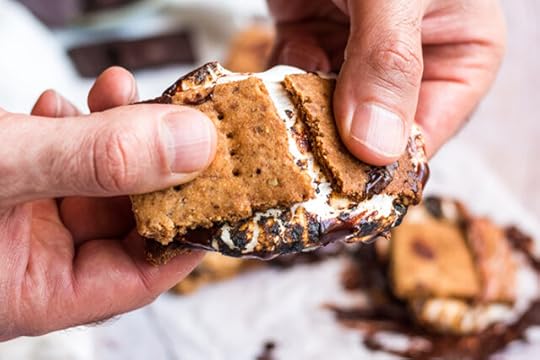 There’s nothing like sitting around the fire in the fall, sipping on something warm in your mug. And where there’s a fire, there are s’mores.
There’s nothing like sitting around the fire in the fall, sipping on something warm in your mug. And where there’s a fire, there are s’mores.
If you’re eating closer to the way your ancestors did, you probably politely pass when the s’mores come out. Now, you can join in the fun. You’ll never be left wanting for campfire s’mores again thanks to these Paleo graham crackers and homemade gooey marshmallows.
Making your own crackers may be intimidating, but it’s easy. The dough comes together quickly and is fun to roll and cut out. They would be a great activity to do with kids or friends, and the dough is egg-free so you can taste it before baking.
If you have time, we highly recommend making your own marshmallows. We’ve linked a few great recipes below. If you’re in a bind, there are also some decent pre-made options for marshmallows, like Smashmallow® brand.
Here’s how to do it.
Keto, Gluten Free, Primal S’mores Recipe
Serves: 6
Time in the kitchen: 20 minutes
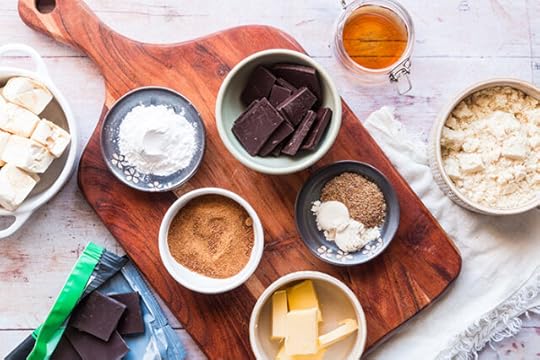
Ingredients
Graham Crackers
1/4 c melted salted butter
1 Tbsp. maple syrup
1 c fine almond flour
2 Tbsp. tapioca starch
2 Tbsp. coconut sugar
2 tsp. ground flaxseed
2 tsp. coconut flour
1/4 tsp. cinnamon (optional)
For the S’mores
1 batch of marshmallows
1 bar of your favorite dark chocolate (choose a brand with low sugar)
Instantly download your Keto Reset Diet Recipe Sampler
Directions
In a bowl, combine the butter and maple syrup.
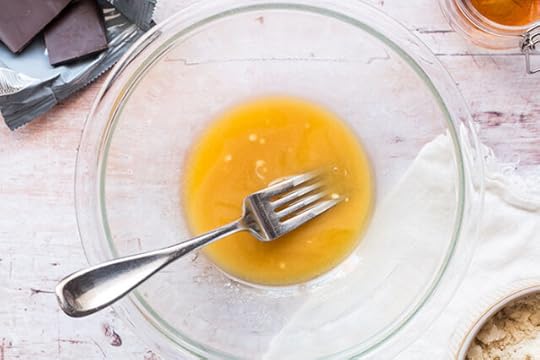 Pour in the almond flour, tapioca starch, coconut sugar, flaxseed, coconut flour and cinnamon.
Pour in the almond flour, tapioca starch, coconut sugar, flaxseed, coconut flour and cinnamon.
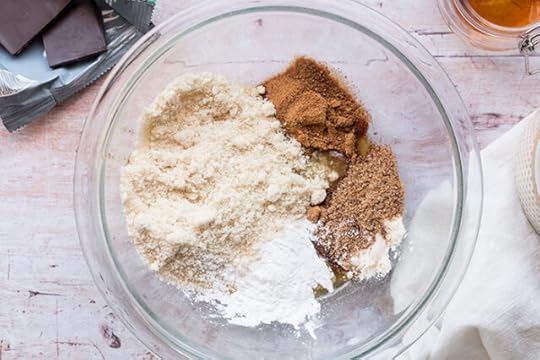
Mix together and allow the mixture to rest for a few minutes.

Preheat your oven to 325 degrees Fahrenheit. Form the dough into a ball and place it between two pieces of parchment paper. Use your hands or a rolling pin to flatten the dough out into a thin rectangle. The dough should be very thin, no more than 1/8” thick.
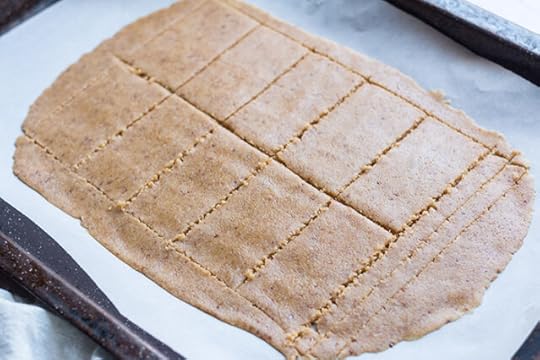 Use a sharp knife to outline a rectangle in the dough, then cut rectangular crackers within the larger rectangle. Don’t worry about cutting all of the way through the dough or separating the crackers you’re cutting. As long as the crackers are scored, they will break into crackers easily after baking. Use a fork to prick 3-4 sets of dots across each of the rectangular crackers.
Use a sharp knife to outline a rectangle in the dough, then cut rectangular crackers within the larger rectangle. Don’t worry about cutting all of the way through the dough or separating the crackers you’re cutting. As long as the crackers are scored, they will break into crackers easily after baking. Use a fork to prick 3-4 sets of dots across each of the rectangular crackers.
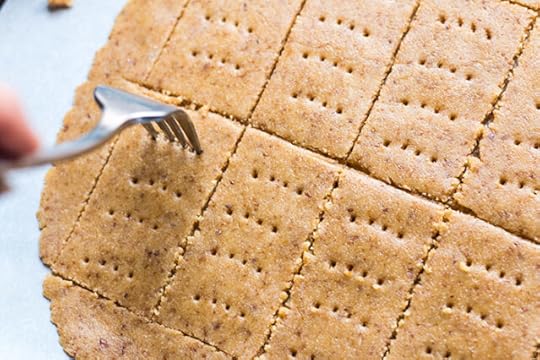
Take the remaining leftover dough that you cut away from the rectangle and repeat to form more crackers if there is enough dough.
Bake the crackers at 325 degrees for 16-18 minutes, or until the edges of the crackers are golden. The crackers can go from golden to burnt quickly, so keep an eye on them. Allow them to cool prior to cutting them into pieces.
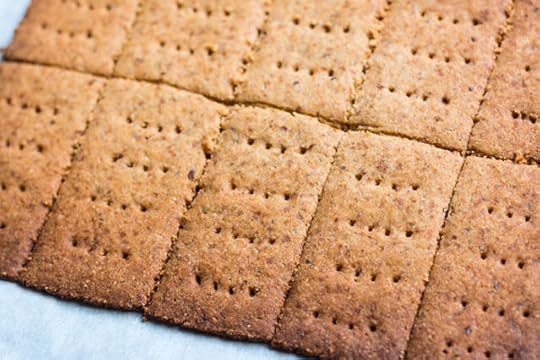
Press your marshmallows onto metal skewers and roast them to your liking. Bonus points if you have a fire pit or somewhere outside to get them nice and toasty, but toasting them carefully on a gas stovetop will also do the trick.

If your marshmallow isn’t hot enough to melt your piece of chocolate, you can place a piece of chocolate on top of one of your graham crackers and place them in the oven for a minute or so to soften.
Place the marshmallow on top of the cracker and chocolate stack and then place the second graham cracker on top of the marshmallow. Press down gently to encourage the marshmallow and chocolate to melt together.

These are messy, but in a good way.
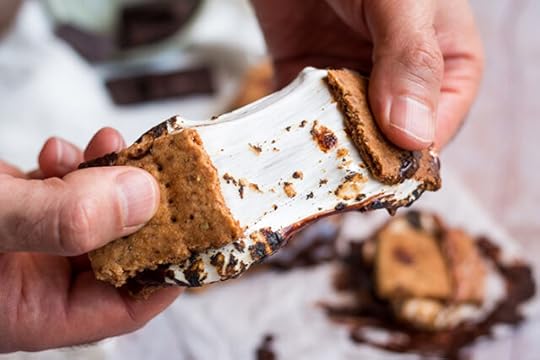 The smores are best warm, so enjoy immediately.
The smores are best warm, so enjoy immediately. 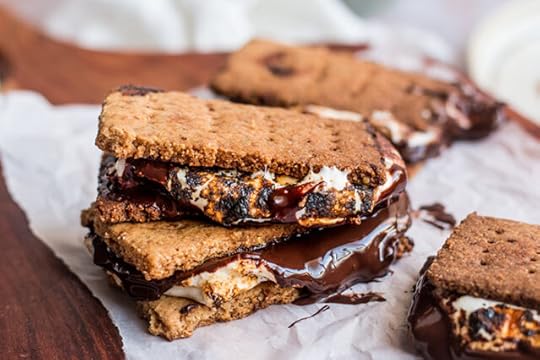
Nutrition Facts (per 2 crackers):
Calories: 220
Fat: 18g
Total Carbs: 13g
Net Carbs: 10g
Protein: 4g
The post Better S’Mores [Primal, Gluten Free, Paleo, and Keto] appeared first on Mark's Daily Apple.



October 9, 2020
Weekly Link Love — Edition 102

Research of the Week
Some people can’t smell stinky fish.
If you think you’re about to drink some sugar but drink fake sugar instead, your body reacts as if you drank the real stuff.
Wearing lip balm reduces droplets produced through talking.
Having had the common cold may reduce the chance of severe COVID-19 infections.
Ketones seem to make white adipose tissue act more like brown fat.
New Primal Blueprint Podcasts
Episode 450: Zach Bush MD: Host Elle Russ welcomes Zach Bush MD to the podcast.
Primal Health Coach Radio Episode 79: Laura and Erin chat with Lisa McDonald.
Media, Schmedia
Didn’t we already know this decades ago?
Interesting Blog Posts
What happened to all the Bronze Age cities?
What might a “new morality” look like?
Social Notes
It’s true.
Everything Else
Someone check if Hell froze over.
Things I’m Up to and Interested In
This isn’t good news: People’s balance is worse than ever.
Great content: A compendium of 19th century Italian case studies on using the carnivore diet to treat diabetes.
Insane paper: In which the author proposes we “painlessly” kill off predators in the wild to prevent herbivores from suffering.
Interesting question: Why are North and South India so different on gender?
One of the more relevant pieces I’ve read: Acceptance parenting.
Question I’m Asking
Are you going to celebrate Halloween? If so, how?
Recipe Corner
Keto tacos. Clever idea with the cheese shell.
This pumpkin mug cake looks like a nice little treat.
Time Capsule
One year ago (Oct 2 – Oct 8)
HIIT vs HIRT: Reducing Workout Stress to Increase Fitness – Go easier to go faster.
Mark’s Favorite Exercise: Trap-Bar Deadlift – I just love it.
Comment of the Week
“LOL you’re on the wrong website Sheida.”
-Actually, TGJ, this might be the website she needs most of all.
The post Weekly Link Love — Edition 102 appeared first on Mark's Daily Apple.



October 8, 2020
Ask a Health Coach: How Bad Is It Really?
 Love your weekly cheat meal? Got picky eaters in your family? Or maybe you’re high-tailing it to get the perennial favorite, the PSL as we speak. This week, PHCI coaching director, Erin Power is here to answer the pressing question: how bad is it really? And you might be surprised at the answers. Remember, you can ask your questions over in the MDA Facebook Group or below this post in the comments section.
Love your weekly cheat meal? Got picky eaters in your family? Or maybe you’re high-tailing it to get the perennial favorite, the PSL as we speak. This week, PHCI coaching director, Erin Power is here to answer the pressing question: how bad is it really? And you might be surprised at the answers. Remember, you can ask your questions over in the MDA Facebook Group or below this post in the comments section.
Anne-Marie asked:
“I can’t resist those pumpkin spice lattes. Tell me they’re not as bad for me as I think they are.”
Who doesn’t look forward to a good ol’ PSL? The cinnamon, the nutmeg, the whopping 50 grams of sugar. While it’s true that sugar is linked to so many things you don’t want, like diabetes, high blood pressure, and obesity1 to say the least, it’s not actually a hill worth dying over. At least not for me.
Get your fall spice fix with Primal Kitchen® Chai? ?Tea? ?Collagen? ?Keto? ?Latte? Drink Mix
A lot of my clients have been trained to panic when they see the sugar grams start to creep up. They ask me how many grams they should aim for per day. Or they want a suggestion to replace the sugar in their favorite *treats* with a more natural sweetener like honey or maple syrup or a non-caloric one like monk fruit.
But here’s the deal, sugar is sugar. And assuming you’re not sucking down seasonal drinks like this every single day, the calories you ingest aren’t going to make-or-break the metabolic bank. That’s what’s so great about our bodies. We can train them to freak out when we eat something that we think we’re not supposed to even look at, just as easily as we can have a knowing trust that our bodies have the metabolic flexibility to handle it.
If you haven’t heard me say it before, our bodies are miraculous organisms. We are designed to constantly respond and adapt to changes in our environments, thriving in some instances and effortlessly course-correcting in others.
I’m not saying that sugar isn’t highly addictive. It absolutely can be.2 But there’s a difference between having a few squirts of PSL syrup in your every-so-often latte and regularly consuming overly processed frankenfoods that are not only loaded with multiple types of sugar, but also industrialized oils and preservatives that your body doesn’t even recognize.
Plain and simple, I just can’t get too worked up over sugar. And my *official* recommendation is that you shouldn’t either. Especially around something that will be gone (at least temporarily) before Thanksgiving rolls around.
James asked:
“I know cheat meals are supposed to keep you on track, but I’m always massively hungry the next day. Any advice?”
Honestly, I cringe when I hear the phrase cheat day. It’s a term that’s rooted in diet culture and reinforces the labeling of “good foods” versus “bad foods.” But for the purpose of answering your question, I’ll move past my own issues.
For those who don’t know, a cheat meal is one that’s typically higher in calories and carbohydrates than you’re used to eating. Basically, it’s a meal where you can eat whatever you want without worrying about it falling into your macro split or fitting inside the Primal Blueprint food pyramid.
And yes, scheduled cheat meals can have benefits. They can help you replenish your will to stay the course, breaking up a potentially monotonous protein-and-veg-rich diet. There’s even some proof that they can kickstart your metabolism and keep your weight loss going by increasing leptin levels and restore thyroid function – two things that often get compromised during a prolonged caloric restriction.3
So, there are definitely pluses.
However, the negative aspects of a refeed might outweigh the benefits, and it looks like you’re noticing some of those negatives right now.
A lot of people view the way they eat as a diet, which to me, implies a temporary lifestyle change. If that’s the case with you, you might be using your cheat meal to reward yourself for making good choices. Unfortunately, this kind of thinking can backfire, leading to overeating, bloating, and a host of other detrimental consequences. And that’s just during the cheat meal itself.
While some people find that a cheat meal reduces their hunger the next day, it sounds like your body is getting a different message. Your body might not recognize that your refeed is over, so it sends you the signal to keep eating all the carbs. That’s what makes a cheat meal turn into a cheat day or even a whole cheat weekend.
My goal as a health coach is to help my clients develop an effortless relationship with food. One where there’s no “good” or “bad” foods, no need to refeed, no yo-yo-ing, and no feelings of guilt, shame, or days spent white-knuckling it through cravings.
If cheat meals work for you, more power to you. But (and this is just a hunch here), I don’t think they do. I think they cause more challenges than they’re worth. You might be better off to adopt an 80/20 split where you focus on the foods that make your body feel good 80% of the time and let life happen the other 20%.
Marc asked:
“I feel pretty awful about some of the things I feed my kids, but they’re picky eaters. Any tips or tricks for making the transition to a primal diet with young children or is it better to wait ‘til they’re older and have a more mature palette?”
I don’t have kids, so I can’t personally comment on that from a parental perspective. But most of my clients are moms and dads, so I’ll ask you the same question I ask them when this topic comes up.
Who does the grocery shopping in your house? Is it your kids? Or is it you and/or your partner? I realize I’m being a bit sarcastic here, however I’m trying to prove a point.
Assuming your kids aren’t buying their own food, you actually have a say in what goes in their mouths. If you want them to eat cauliflower rice instead of white rice, don’t buy white rice. If you want them to choose fresh fruit over junk-filled fruit leathers, don’t put them in your cart.
I already know what you’re thinking. What if they don’t eat? Won’t they starve? How will they get enough nutrients?
I will gladly answer that with: How many nutrients do you think they’re getting from their grape drink and cheese puffs? Not many. Not only that, you’re slowly setting them up to be part of a growing epidemic of young people who have to manage obesity-related diseases, like type 2 diabetes, before they even move out of the house.4
Here’s the good news though. It’s possible to change your kids’ preferences for certain foods. Studies doneat the University of Alberta showed that children who were involved in the preparation of foods were actually more likely the make a healthier choice at mealtime.5 Here are a few strategies to make the transition easier:
Don’t force it. No one likes to be pressured into trying new things — especially when those things are green and leafy and totally foreign to them.
Keep it simple. Sometimes kids aren’t being picky with flavors as much as they prefer their food to be less fussy. So, leave the complex sauces and seasonings off the plate for now.
Get them involved. Looking through recipes or chopping veggies together helps kids feel like they have a say in the process, giving them a sense of control, which in turn, makes them feel good about choosing healthier options.
Walk the talk. Make sure your behaviors match your language. If you want them to eat more Primally, yet you’re stocking up on junk food, it sends mixed messages. Stock your house with foods you want them to eat and leave the other stuff at the store.
What are your thoughts? Do you agree? Share your experiences in the comments.
References https://www.ncbi.nlm.nih.gov/pmc/arti...https://www.ncbi.nlm.nih.gov/pmc/articles/PMC3856718/https://www.cdc.gov/diabetes/prevent-type-2/type-2-kids.htmlhttps://www.cambridge.org/core/journals/public-health-nutrition/article/involvement-in-home-meal-preparation-is-associated-with-food-preference-and-selfefficacy-among-canadian-children/C4347E7475C945893A82B19E5F93CC90
The post Ask a Health Coach: How Bad Is It Really? appeared first on Mark's Daily Apple.



October 7, 2020
How to Eat Meat and Still Reduce Your Environmental Impact
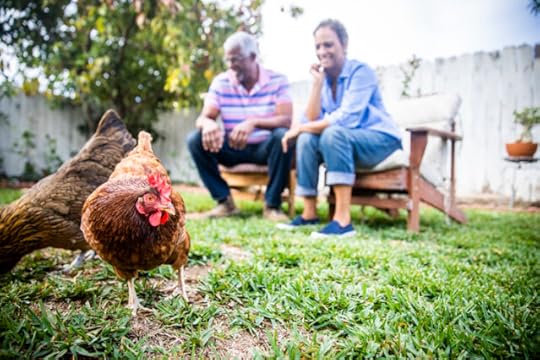 If you listen to the experts, the authorities, the think tanks, eating meat destroys the environment. It “destroys your health” too, of course, but by far the biggest argument being pushed—and the one most regular people implicitly accept as “probably accurate”—is that meat consumption is detrimental to planetary health.
If you listen to the experts, the authorities, the think tanks, eating meat destroys the environment. It “destroys your health” too, of course, but by far the biggest argument being pushed—and the one most regular people implicitly accept as “probably accurate”—is that meat consumption is detrimental to planetary health.
I’m not going to cover the health part. That’s been done to death. If you’re reading this blog post, you probably reject that aspect of the argument. Hell, you might be chowing down on a steak at this very moment. This post is for the people who still worry about the effect of meat on the environment.
It’s a noble concern, one that I share. So today, I’m going to explain how you can eat meat and still reduce your environmental impact.
Stay on track no matter where you are. Instantly download your Primal and Keto Guide to Eating Out
Eat local.
This one is almost entirely self-explanatory. When meat travels across the world to get to your plate, or even halfway across the country, it’s burning through fuel and producing emissions that harm the environment. It has to travel from the farm to the packing plant, from the plant to the shipyard, from the shipyard to the sea, across the sea to the port, from the port to the distribution center, from the distribution center to the store, from the store to your home.
If your meat is local, all those middle men and their emissions are, well, omitted. It goes from the farm to the local abattoir, and then onto the farmers market or local grocer. And sometimes, the farm has their own in-house slaughtering and packing setup, and you cut the middle men out even more.
If enough people do this, the local market expands, and the effect multiplies. So do it!
Eat grass-fed, sustainably-farmed animals.
There’s an entire book about this: Robb Wolf and Diana Rodgers’ Sacred Cow. They also did a very relevant guest post on this stuff.
The basic gist is that animals raised on pasture with rotational grazing that mimics the way herbivores travel and eat in nature can build up the soil, fertilize the land, and trigger greater plant growth and stronger, deeper root systems that further enrich the soil and its bacterial inhabitants. It’s almost like pasture needs herbivores just as much as herbivores need pasture.
More than that, not all land is fungible. There’s a ton of land that’s inhospitable to crops but perfect for livestock. If you got rid of livestock, you’d be wasting that land; you couldn’t just plant some corn on it. It’s livestock or nothing.
Where do your omegas come from? Get sustainably sourced, third-party tested Omega-3s
Remember that there’s more to the environment than carbon emissions.
There are many other aspects of the environment to observe and protect—and proper meat can help.
When you get locally packed meat that’s wrapped in butcher paper ten miles from your house, there’s less plastic and less airborne pollutants gumming up your lungs.
When you eat meat that improves the soil, you’re contributing to building the local ecology and preserving soil nutrition.
When you eat animal foods, you obtain the nutrients you need to generate energy and maintain metabolism. Most vegans I know are perpetually cold, always asking if you “can turn the heat up.”
The local environment “counts.”
Eat the bones, skin, guts, and organs—the whole shebang.
The average cow is half muscle meat and half “other stuff.” Most people only eat the muscle meat and ignore the other stuff, which includes bones, connective tissue, cartilage, tendons, and other collagenous material. The other stuff ends up in pet food or used by other industries, but we could be eating it, getting healthier, wasting less food, and reducing the number of cattle that have to be killed and produced in the process. Big waste right here.
Eat the other stuff, folks.
Eat small fatty fish.
Yeah, yeah. Omega-3s, selenium, iron, calcium, iodine, protein. We know. Nutrition aside, these things are great choices for the environment. There are tons of them. Plenty available. The problem is that a huge portion of them go toward feeding farmed carnivorous fish like salmon, and you lose calories in the conversion process. You could feed farmed Atlantic salmon five pounds of sardine slurry to produce one pound of edible salmon, or you could eat those five pounds of sardines yourself.1
What’s more wasteful? What’s less wasteful? You tell me.
Buy quarters, halves, or whole animals.
Back over 10 years ago, I was telling people to start cowpooling—to go in on an entire cow with their friends. That’s when it was a new concept for most non-rural residents, and it wasn’t the easiest thing for people to pull off. First you had to find the cow, then you had to find some friends who wouldn’t immediately call you crazy for wanting to buy 1200 pounds of beef.
Now it’s easier. Now more people than ever are interested in buying and storing large amounts of high-quality grass-fed meat. Don’t believe me? Go check the local stores for chest freezers. They’re in short supply. People know. People are ready.
Get some chickens.
This is as local as it gets. Instead of having eggs trucked in from halfway across the country, or even a chicken operation 100 miles away (which is way better than the former), you go out to your backyard in bare feet and grab a couple fresh eggs from your hens. You don’t even have to wear clothes to do it.
The eggs are better, too. Way better. And you can run all sorts of cool experiments on them.
Add paprika and marigold flowers to the feed to boost carotenoid content (and improve yolk color).
Add vitamin D drops to their food to increase extra-bioavailable vitamin D in the yolks.
Get throwaway greens from the farmer’s market or grocery store to boost micronutrient content (folate, for one) in the eggs.
Add kelp meal for iodine.
Add fish meal for phospholipid-bound omega-3s.
There are probably many more things you can do to tweak the nutrient content of your backyard eggs (and if anyone out there has some ideas or input, let us know in the comment section!).
It’s great fun and most importantly, you are not impacting the environment. You have the number of hens you need to get the number of egg you need. You’re composting their manure, not dumping it. There’s no toxic runoff from cramming 50,000 birds in a small space. You’re feeding scraps from the kitchen, so there’s less waste on that front too. If you have extra eggs (what are “extra” eggs?), you can sell or gift them to your neighbors, thereby reducing their utilization of factory farmed eggs and improving the amount of neighborly goodwill and cheer that exists in this world. The entire backyard chicken situation is a huge win all around.
Eat farmed shellfish.
You hear “farmed” and shrink away. Aren’t farmed fish bad for you? Well, not necessarily, for one. Read this post from way back where I go into some of the better farmed fish out there. And two, farmed shellfish aren’t really “farmed” like you’re thinking. Farmed shellfish live almost exactly like wild shellfish live:
Out in the ocean, attached to something.
Obtaining sustenance from the ocean.
Shellfish farmers don’t feed their shellfish. They just raise the little guys, see that they have a safe home in the water off the coast, and largely leave them alone until harvest.
All in all, farmed shellfish have a very low human interference factor. The fewer the inputs, the more we just get out of the way, the better for the environment.
Keep eating meat.
Meat is your heritage. It’s your birthright. It gives us the protein we need to stave off the entropy that seeks to dissemble our cellular structures. It provides the creatine, carnitine, and carnosine that calm our minds and sharpen our wits.
A dysfunctional cell poisons the organism. A problem child disrupts the family. A disintegrated individual whose personal nutrition conflicts with the body’s dietary requirements cannot be the best human they can be—I truly believe that, at some level, someone who eats meat isn’t living up to their potential. They can be better, and it is through better people that the environment prospers.
A non meat-eater isn’t bad. Not all meat-eaters are good. The former can often be great and the latter disappointing; there’s more to human achievement than nutrition (way more). But all else being equal, not eating meat is selling yourself (and the world) short.
Eating meat doesn’t have as large a climate effect as we’ve been told, but it does have an effect on many different aspects of environmental health (including climate).2 And, if you do it the right way, that effect can be a positive one.
So, does this relieve some of your stress? Let me know down below.
References https://www.motherjones.com/food/2011/11/sardines-salmon-fish-farms/]https://www.ars.usda.gov/news-events/news/research-news/2019/study-clarifies-us-beefs-resource-use-and-greenhouse-gas-emissions/
The post How to Eat Meat and Still Reduce Your Environmental Impact appeared first on Mark's Daily Apple.



Mark Sisson's Blog
- Mark Sisson's profile
- 199 followers











